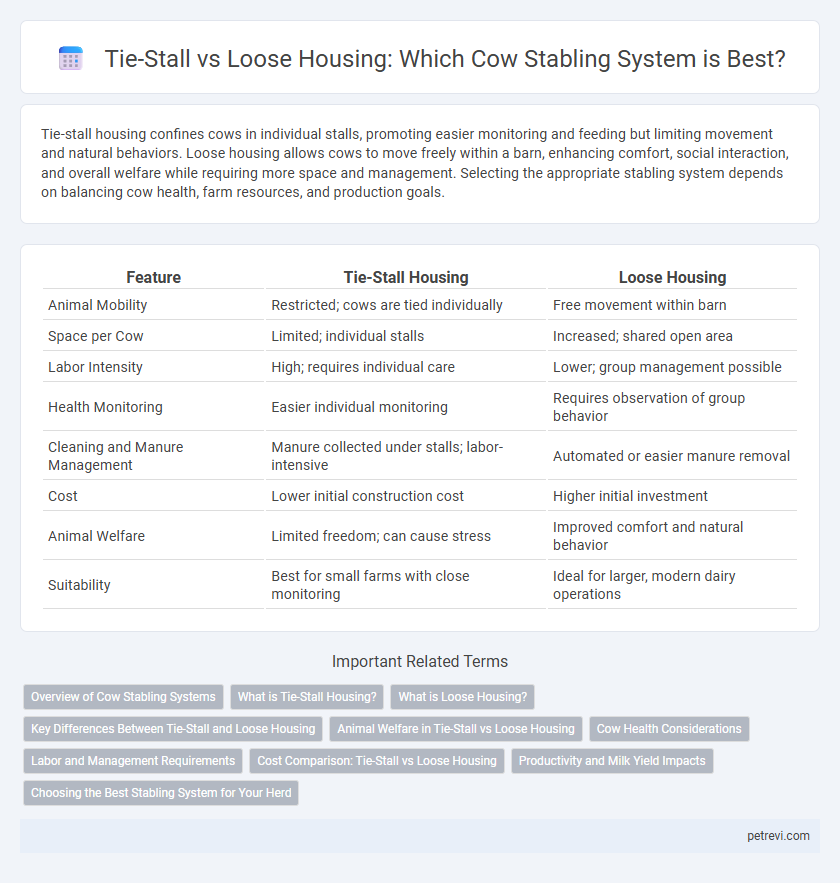Tie-stall housing confines cows in individual stalls, promoting easier monitoring and feeding but limiting movement and natural behaviors. Loose housing allows cows to move freely within a barn, enhancing comfort, social interaction, and overall welfare while requiring more space and management. Selecting the appropriate stabling system depends on balancing cow health, farm resources, and production goals.
Table of Comparison
| Feature | Tie-Stall Housing | Loose Housing |
|---|---|---|
| Animal Mobility | Restricted; cows are tied individually | Free movement within barn |
| Space per Cow | Limited; individual stalls | Increased; shared open area |
| Labor Intensity | High; requires individual care | Lower; group management possible |
| Health Monitoring | Easier individual monitoring | Requires observation of group behavior |
| Cleaning and Manure Management | Manure collected under stalls; labor-intensive | Automated or easier manure removal |
| Cost | Lower initial construction cost | Higher initial investment |
| Animal Welfare | Limited freedom; can cause stress | Improved comfort and natural behavior |
| Suitability | Best for small farms with close monitoring | Ideal for larger, modern dairy operations |
Overview of Cow Stabling Systems
Tie-stall and loose housing are two primary cow stabling systems used in dairy farming, each with distinct management and welfare implications. Tie-stall systems confine cows individually to fixed stalls, allowing precise feeding and monitoring but limiting movement and social interaction. Loose housing enables cows to move freely within a barn, promoting natural behavior and better welfare, although it demands more space and sophisticated management to prevent overcrowding and maintain hygiene.
What is Tie-Stall Housing?
Tie-stall housing confines cows individually in narrow stalls where each animal is tethered by a neck chain, limiting movement but allowing personalized feeding and monitoring. This system supports better control of cow hygiene and health but restricts natural behaviors and reduces exercise opportunities. Tie-stall barns typically require less space per cow compared to loose housing, making them suitable for small-scale farms with intensive management practices.
What is Loose Housing?
Loose housing is a cow stabling system where animals are free to move within a large, open area rather than being confined to individual stalls. This method improves animal welfare by promoting natural behaviors, enhancing cow comfort, and reducing stress. Research indicates that loose housing systems can increase milk production and decrease lameness compared to tie-stall systems.
Key Differences Between Tie-Stall and Loose Housing
Tie-stall housing confines each cow to an individual stall, limiting movement but allowing personalized care and feeding, while loose housing permits cows to move freely within a shared space, promoting natural behaviors and social interaction. Tie-stalls often result in higher labor input due to individual cow management, whereas loose housing demands more space and advanced manure handling systems. The choice between tie-stall and loose housing impacts cow welfare, labor efficiency, and facility design significantly.
Animal Welfare in Tie-Stall vs Loose Housing
Tie-stall housing restricts cows' movement, which may lead to increased stress and lameness, negatively impacting overall welfare. Loose housing allows cows to move freely, promoting natural behaviors, reducing injury risk, and enhancing comfort. Studies show higher welfare scores in loose housing systems due to improved cow health and social interaction opportunities.
Cow Health Considerations
Tie-stall housing restricts cow movement, increasing risks of lameness, mastitis, and respiratory issues due to limited ventilation and hygiene challenges. Loose housing promotes natural behaviors, better social interaction, and improved hoof health by providing spacious resting and exercise areas, reducing stress and injury. Proper bedding management and ventilation are critical in both systems to maintain optimal cow health and milk production.
Labor and Management Requirements
Tie-stall housing demands more intensive labor due to individual cow management, feeding, and cleaning, increasing time per animal but allowing close monitoring of health and productivity. Loose housing systems require efficient labor allocation for group management, with challenges in feeding, bedding, and health checks that benefit from automated technologies. Management in tie-stalls focuses on individual attention, whereas loose housing emphasizes herd dynamics and overall facility maintenance, impacting labor skills and supervisory roles.
Cost Comparison: Tie-Stall vs Loose Housing
Tie-stall housing generally involves lower initial construction costs due to its simpler design and smaller space requirements per cow, making it more affordable for smaller farms. Loose housing systems demand higher upfront investments for larger open barns, advanced ventilation, and bedding materials but can reduce long-term labor expenses by facilitating easier cow movement and management. Operational cost analysis shows tie-stall systems may incur higher labor costs, while loose housing offers cost efficiency in large-scale dairy operations through improved animal welfare and productivity.
Productivity and Milk Yield Impacts
Tie-stall barns restrict cow movement, often leading to lower milk yield and reduced productivity due to limited comfort and higher stress levels. Loose housing systems promote natural behavior and increased cow mobility, resulting in improved milk production and overall health. Studies indicate that cows in loose housing can produce up to 10% more milk compared to those kept in tie-stall systems.
Choosing the Best Stabling System for Your Herd
Tie-stall housing confines each cow to a separate stall, offering individual feeding and easier monitoring, while loose housing promotes natural behaviors with group access to feed and exercise areas that enhance cow comfort and welfare. Research indicates loose housing systems improve milk yield and reduce lameness incidence due to increased mobility, making it a preferred choice for dairy farms prioritizing animal health. However, tie-stall systems may be advantageous for smaller herds requiring precise management and limited space, emphasizing the importance of herd size and farm goals in selecting the optimal stabling system.
Tie-Stall vs Loose Housing for Cow Stabling Infographic

 petrevi.com
petrevi.com